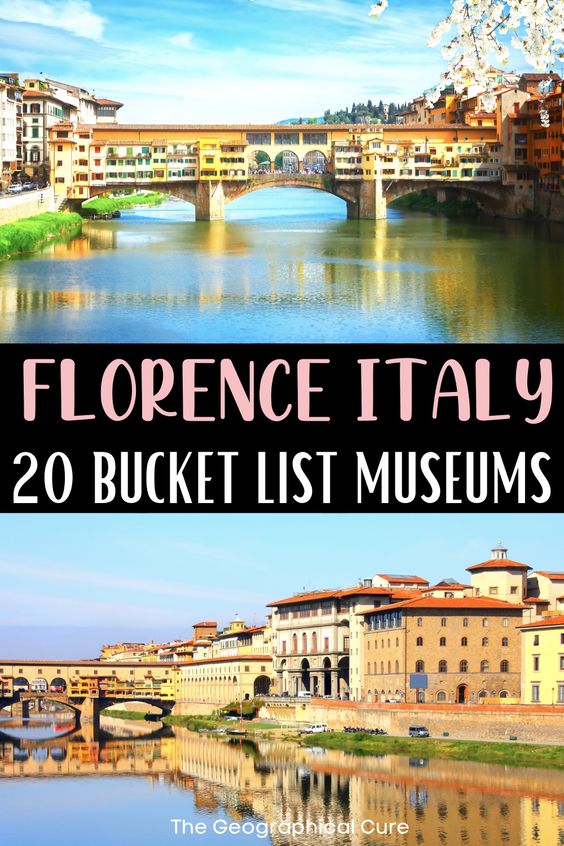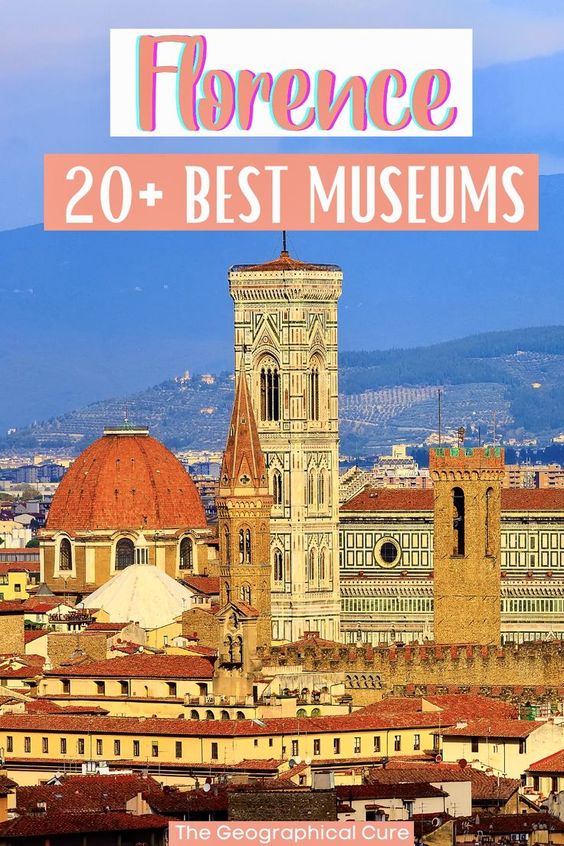Florence is a true hub of the Renaissance, brimming with artistic masterpieces that defined an era of unparalleled genius. It’s packed with incredible museums showcasing the work of artists like Michelangelo, Donatello, and Masaccio.
Having visited these museums myself numerous times, I’ve gathered a wealth of insights to share with you.
We’ll step inside churches adorned with stunning frescoes and wander through elegant palaces. In some places, you’ll find the architecture is just as breathtaking as the artworks themselves.
Best Museums in Florence
1. Uffizi Gallery
Florence is synonymous with the Renaissance period of art history. The Uffizi is its the best museum in Florence and the third most visited site in all of Italy. For art lovers, the Uffizi is a revered place of pilgrimage.
The Uffizi houses the collection of the Medici, a wealthy family of art patrons that ruled Florence for three centuries. The museum has seminal works from the 13th to 18th centuries.
Some of the world’s most famous paintings are in the Uffizi — Botticelli’s Birth of Venus and Primavera, Titian’s Venus of Urbino, Leonardo da Vinci’s Annunciation, Caravaggio’s Medusa and Bacchus, Piero della Francesca’s unflattering portraits of the Duke and Duchess of Urbino, and Raphael’s Goldfinch Madonna.
READ: The 30 Most Important Paintings in Florence
The Uffizi consists of 45 halls of art spread over two floors of the palace. If you have limited time, you should focus your efforts.
The must see halls include the Hall 2 (Giotto), Hall 8 (Lippi), Hall 10-14 (Botticelli), Hall 15 (Leonardo), Hall 35 (Michelangelo), Hall 66 (Raphael), Hall 83 (Titian), and Hall 90 (Caravaggio).
Click here to pre-book a timed entry ticket. On my last visit, I took this 2 hour guided tour and it was wonderful, especially if you’re not an expert on Renaissance art.
2. Galleria dell’Accademia
After the Uffizi, the Accademia Gallery is Florence’s best and most visited museum. People flock in to see what is probably the world’s most famous sculpture, Michelangelo’s David.
The commanding 17 foot sculpture is considered the embodiment of male physical perfection.
Originally, parts of David were gilded. But the gilded surfaces were lost during the statue’s exposure to the elements.
In 1873, David was moved inside to the Accademia.
Michelangelo’s Prisoners grace the Hall of the Prisoners at the Accademia. They are four unfinished male nudes that were originally intended for the Tomb of Pope Julius II.
ou can see Michelangelo’s approach to carving; the figures appear to be emerging from the marble.
Other must see Accademia masterpieces include Giambologna’s Rape of the Sabines, Pacino di Bonaguida’s Tree of Life, Jacopo di Cione’s Coronation of the Virgin, and Daniele da Volterra’s Bust of Michelangelo.
The Accademia is always swamped with visitors. You should definitely pre-book a skip the line timed entry ticket for this popular Florence attractions. You can also opt for a 1.5 hour guided tour with fast track ticket.
3. National Museum of the Bargello
The Bargello dates from 1255. It was first a prison and then the seat of government in Florence.
In 1865, the Bargello opened as a museum by royal decree. Now, it’s one of the best museums in Florence.
The Bargello houses an amazing collection of Renaissance sculptures. The most important works are in the Michelangelo and Donatello rooms.
Those include Michelangelo’s first major sculpture, Bacchus, and his Pitti Tondo, Donatello’s acclaimed Bronze David and St. George, and Bernini’s Bust of Costanza.
Commissioned by Cosimo de Medici the Elder, Donatello’s Bronze David is the most famous piece in the museum. It’s a daring depiction of a biblical theme.
A nubile David is peculiarly depicted wearing no clothes except for a hat and boots, perhaps to suggest his underdog status. The statue is affectionately nicknamed “Puss ‘N Boots.”
The Bargello also houses the Competition Panels. In 1401, Florence held a competition for a set of bronze doors to be made for the Baptistry of the Duomo.
Artists submitted bronze samples. Ghiberti and Brunelleschi were the finalists, with Ghiberti winning the competition.
The museum also houses pivotal Renaissance sculptures by the underrated artist Andrea del Verrocchio, who’s best known as Leonardo da Vinci’s teacher.
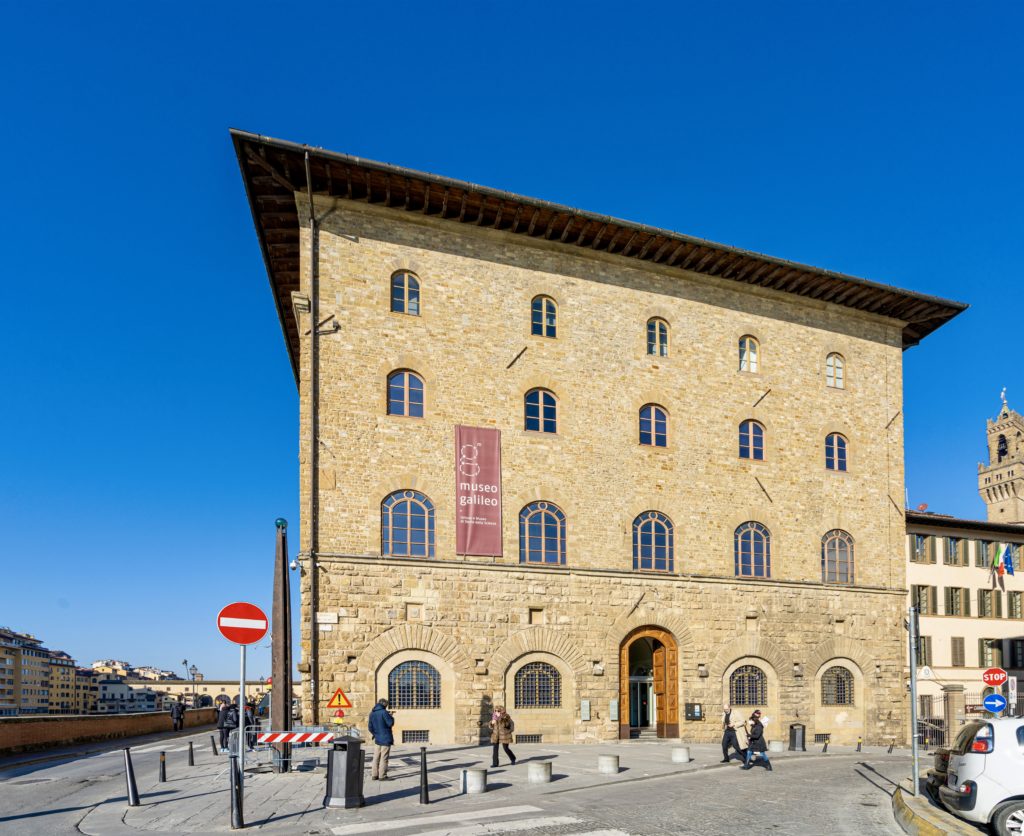
4. Galileo Museum
After pondering great artists, perhaps it’s time to be awed by the greats of science. The Galileo Museum is housed in a medieval palace, the Palazzo Castellani, that was renovated in the 1800s.
When Galileo proclaimed that the earth revolved around the sun, he got in a heap of trouble. Under pressure, his “friend” Pope Urban VIII made Galileo recant his scientific findings.
Galileo was tried by the Inquisition and exiled from Florence. During the Age of Enlightenment, scholars realized that he was right all along.
Over two floors of the Galileo Museum, you’ll find an impressive collection of scientific instruments from the Renaissance, including telescopes, clocks, anatomical models, and astrological models.
They reflect Italy’s claim as the center of the first scientific revolution.
Room 4 is the highlight of the museum. It has Galileo’s tools on display, including his famous telescope. Even his middle finger!
If you want to pay homage to Galileo, his tomb is in the Basilica of Sante Croce, along with other celebrity tombs.
Click here to pre-book a ticket to the museum.
5. Casa di Dante | Dante’s House
The Casa di Dante is supposed to be an exact replica of the house Dante lived in in Florence. Dante Alighieri is Italy’s famed 13th century poet and author of The Divine Comedy.
In this epic poem, Dante creates a fictional version of himself, traveling through hell, purgatory, and paradise. His image driven descriptions were hugely influential, producing a plethora of visual art.
Dante famously fell in love with Beatrice Portinari, writing about her as an idealized love in his Vita Nuova.
If you have an abiding fascination with the great 13th century poet, you’ll probably be interested in the displays. There’s many copies of The Divine Comedy. Nearby is the church where Beatrice attended mass.
6. The Medici Chapels
The Medici Chapels are home to the largest number of Michelangelo sculptures in Florence. It’s part of the Basilica of San Lorenzo Complex. But it has a separate entrance and separate ticket.
Michelangelo himself designed the Medici Chapel between 1520-34. The chapel’s coffered dome is similar to Rome’s Pantheon. The walls are clad with pink green, gold, and white marble.
Michelangelo carved six tomb statues — the effigies of Giuliano and Lorenzo de Medici and the allegories of Night and Day and Dusk and Dawn.
Night is regarded as one of Michelangelo’s finest works. To me, the effigy of Giuliano is extraordinarily beautiful.
And the museum has a secret room! In 1527, Michelangelo returned to Florence from Rome to defend republican forces during a civil war.
When Florence fell, Michelangelo retreated into a secret room below the chapel until he received a pardon from Medici pope Clement VII.
Michelangelo’s secret room wasn’t discovered until 1975, when a museum director spotted a trap door. The room contains charcoal sketches and doodles by Michelangelo on the walls, identified because they replicated his known works.
The room opened to the public in November 2023 on a very limited basis. Tickets are hard to come by though. If you can’t score one, there’s a video and some of his charcoal drawings on display.
7. The Laurentian Libary
Commissioned by Pope Clement VII, the Laurentian Library is a revolutionary and blissfully uncrowded masterpiece. Construction began in 1524 and the library opened in 1571. It now functions as a museum, not a library.
The Laurentian Library consists of a reading room and a 48 foot vestibule built atop the San Lorenzo cloisters. It has one of the world’s most important collections of manuscripts, which belonged to the Medici family.
In designing the library, Michelangelo broke away from classical tradition and rules of proportion. He designed a dream-like space with curves and unusual configurations.
The seemingly oversize Triple Staircase conveys a sense of movement. It seems to pour forward like pools of liquid. It may be the first freestanding staircase in architectural history.
The walls are decorated with architectural elements such as extremely large low-hanging brackets.
Some of the elements are put into niches, making architecture the artwork. Columns are set into the wall or appear to rest on the corbels.
Unlike the vestibule, the Reading Room develops horizontally. There are two series of wooden benches, called plutei. There’s a white and red terra cotta floor and a coffered ceiling.
Michelangelo’s dramatic and inventive architectural style marked the beginning of Mannerism, a late Renaissance period that reinvented and put a stylized twist on classicism.
8. Museum of the San Marco Monastery
In 1437, Cosimo de Medici decided to rebuild a crumbling Dominican convent complex.
He hired the famed architect Michelozzo for the architectural changes and commissioned Fra Angelico to fresco the walls.
A highlight is the Sala dell’ Ospizio (the Hospice Hall).
This is where the most important Fra Angelico paintings are housed, including among others The Last Judgment, The Crucifixtion and Saints, and The Annunciation (at the top of the stairs).
There are also seminal works by Ghirlandaio, Michelangelo’s teacher, including a Last Supper fresco in the Refectory.
You can also visit the old monks cells on the second floor. There’s a plain room where the fanatical monk Savonarola, the scourge of the Medici, lived and worked.
Also stop in to peer at the simple cell where Cosimo de Medici (the Elder) came to meditate. It’s decorated with Fra Angelico’s Adoration of the Magi.
Here’s my complete guide to the treasures of San Marco Monastery. Click here for a skip the line ticket. Click here for a fascinating tour that gives you insight into Fra Angelico, Savonarola, and the Medici.
9. Palazzo Vecchio
This stately medieval fortress dates from the 13th century. Like the Duomo, it was constructed by architect Arnolfo di Cambio.
Steeped in history, the Palazzo Vecchio was Florence’s seat of power. It was the home of the City Council that governed the Republic of Florence.
On the first floor of the palace, you can visit the Hall of the Five Hundred. It’s the largest room in any palace in Italy and decorated with frescos by Giorgio Vasari.
On the second floor are the sumptuously decorated private rooms of the Medici with more stunning frescoed ceilings.
You’ll also find Donatello’s groundbreaking Judith and Holofernes sculpture in the Hall of Lilies.
Click here to pre-book a ticket to Palazzo Vecchio. Click here to book a 1.5 hour guided tour with fast track ticket.
Another popular 2 hour guided tour includes the palace and a climb of the Tower of Arnolfo. You can also book a private guided tour.
10. Opera del Duomo Museum
The newly renovated Opera del Duomo Museum is an absolute must see site in Florence. It’s housed in the Piazza del Duomo at the back of Giotto’s Bell Tower, and offers a nice view of the dome from its terrace.
The museum houses works that were removed from the Duomo complex or brought in from outside for conservation. With 750 pieces, it’s the world’s largest collection of monumental Florentine sculpture.
The first thing you see when you walk in the museum is the Hall of Paradise. The hall contains a magnificent reconstruction of a Duomo facade, torn down in 1587 in favor of a Renaissance facade.
The other must see masterpieces in the Duomo Museum are Ghiberti’s Gates of Paradise (the world’s most famous doors), Michelangelo’s unfinished Florence Pieta, and Donatello’s compelling Penitent Magdalene.
One of Michelangelo’s last masterpieces, the Florentine Pieta, is currently being restored behind glass walls.
Click here for a guided tour of the Duomo Museum and Brunelleschi’s dome.
11. Gucci Garden
Fashion lovers should stop in at the Gucci Garden Museum.
Born in 2011, the Gucci Garden is housed in the historic Palace of Merchandise in the Piazza della Signorina. The palace formerly housed the court that resolved disputes among the artist guilds.
Over three floors, the museum tells the story of the Italian fashion powerhouse, known for their fashion and leather goods, transformed from a tiny start up to Italy’s most famous brand.
The collection contains some of Gucci’s iconic pieces.
12. Museum of Orsanmichele
The Church of Orsanmichele is noted for its incredible sculpture, decorating the exuberant Gothic facade.
The facade has 14 niches, each one housing a statue of a patron saint commissioned by Florence’s merchant guilds.
Created by the best artists of the time, the exterior sculptures are now copies. The monumental originals are on the top floor of the church in the Orsanmichele Museum.
By far, Orsanmichele’s most famous sculpture is Donatello’s St. Mark. It’s the first truly Renaissance piece of art.
St. Mark marked a revival of classical themes and naturalism. St. Mark was even given a receding hairline. Donatello’s famous St. George was also once at Orsanmichele, but was moved to the Bargello.
Orsanmichele also has three sculptures by Ghiberti — St. John the Baptist (the first significant Renaissance statue in bronze), St. Matthew (Ghiberti’s most important sculpture), and St. Stephen.
And also a famous sculpture by Andrea del Verrochio, Doubting Thomas. Verrochio was Leonardo da Vinci’s teacher.
Tip: The museum is not open daily. But you should really try to see it if you can get there on Monday or Saturday.
13. Pitti Palace
The absolutely awesome Palazzo Pitti is located across the Arno River. It’s in the off the beaten path Oltrarno district that’s now Florence’s trendiest neighborhood.
The palace is one of Florence’s most stunning architecture gems. In 1549, Cosimo de’ Medici’s wife purchased the Pitti Palace.
It became the Medici’s principal private residence. The Medici expanded it and placed art galleries in its interior. It’s a beautiful place to see in situ art, piled on top of each other.
The most important museum is certainly the Palatine Gallery. It occupies the left wing of the first floor.
The gallery houses an impressive collection of over 500 paintings, displayed amid lavish furnishings.
It includes old masters works by Botticelli, Raphael, Titian, Rubens, Caravaggio, and other European and Italian painters.
My favorites were the eight stunning Raphael portraits in the Raphael Room, including Agnolo Doni, Maddalena Doni, La Velata, and Portrait of Tommaso Inghirami.
Click here to pre-book a ticket to the Pitti Palace. Click here to book a guided tour of the magnificent museum.
14. Baptistry of St. John
The Baptistry sits in front of the main facade of Florence Cathedral. Dating from 1059, it’s over a thousand years old. To locals, the Baptistry is Florence’s most significant monument. Yet, it seems like an underrated gem.
The Baptistry is octagonal in shape, inspired by ancient Roman mausoleums. It has three magnificent sets of bronze doors.
On the eastern side are the famous golden “Gates of Paradise” designed by Lorenzo Ghiberti and nicknamed by Michelangelo. The originals are now housed in the Duomo museum.
On the north side, you’ll find another set of Ghiberti doors, created in 1403-24. The doors depict scenes from the passion of Christ.
They were the result of the famous 1401 competition among artists I mentioned above, which basically kicked off the Renaissance era.
On the south side, the doors date from 1330. They were designed by Andrea Pisano, a student and collaborator of Giotto. They show scenes from the life of St. John the Baptist. The Pisano doors were recently renovated.
Inside the Baptistry, the high altar houses Florence’s most precious relic, an index finger of John the Baptist. This relic drew crowds for centuries.
The Baptistry is lined with ancient Roman columns of gray granite, likely repurposed from the ancient Roman Forum down the street.
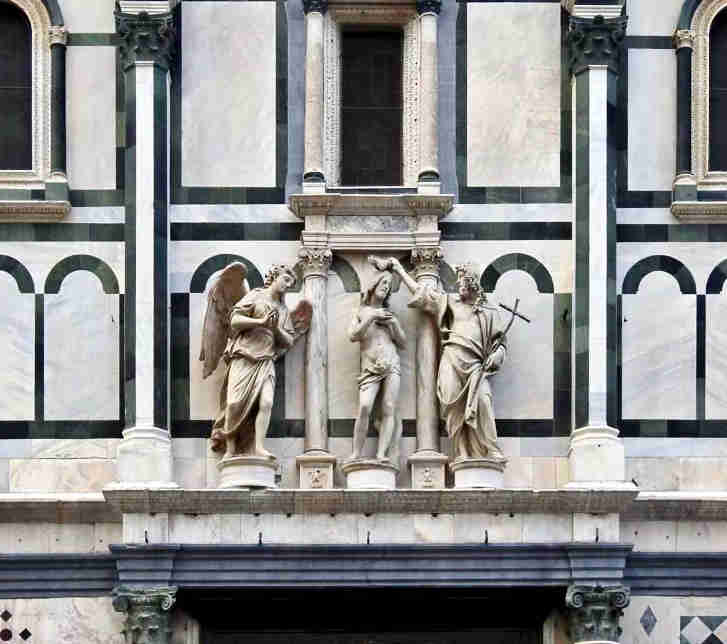
The highlight of the Baptistery is a stunning golden Byzantine style ceiling fresco.
The mosaic tells the story of the Last Judgement, the apocalyptic tale where Jesus determines who will go to heaven and hell. Jesus is 19 feet tall. There’s a shockingly low number of people depicted as heading to heaven.
Here’s my guide to Florence’s Baptistery. Click here for a combined ticket for the Duomo, the Baptistery, and the Duomo Museum.
15. Opera Museum of Sante Croce Basilica
The Basilica of Santa Croce is one of the best museums in Florence and a must visit site for lovers of Renaissance art. It dates from 1280.
The basilica has one of the greatest assemblages of frescos, painting, sculptures, and celebrity funeral tombs in the world.
The highlight are the frescos by Giotto in the Bardi Chapel and the Peruzzi Chapel. There are also frescos by his students Taddeo and Agnolo Gaddi.
You can also pay homage to Michelangelo. The tomb in the basilica was designed by the renowned Italian painter, architect, and art historian Giorgio Vasari.
Like the Duomo, Santa Croce has its own museum, the Museo dell’Opera di Santa Croce. Founded in 1900, the Santa Croce Museum is in the church’s former Refectory. It houses works from the Florentine school.
In 1966, the space was damaged by catastrophic flooding of the Arno River. It was carefully restored, though some damage was irreversible. The museum reopened in 1975.
In the museum, you’ll find many frescos, sculptures, sketches, etc. The must see masterpieces include:
- Cimabue’s Crucifix
- Donatello’s St. Louis of Toulouse
- Taddeo Gaddi’s The Last Supper and the Tree of Life
- Bronzino’s Christ’s Descent into Limbo
- Francesco Salviati’s Deposition from the Cross
There’s also a beautiful collection of terra-cotta tiles by the Della Robia School.
Click here to pre-purchase a skip the line ticket. Click here to book a ticket + guided tour of the basilica.
16. The Da Vinci Museum
Leonardo da Vinci’s namesake museum is a testament to the breadth of genius of this Renaissance man. Leonardo didn’t just paint the Mona Lisa, The Last Supper, and other seminal works.
Rather, Leonardo was an innovative spirit, going so far as to rob graves to learn human anatomy.
He was obsessed with flying and weaponry. Leonardo said “I have been impressed with the urgency of doing. Knowing is not enough; we must apply.”
His museum is devoted to his numerous designs and inventions. The exhibits include models, manuscripts, and interactive displays about the study of gravity and mechanics.
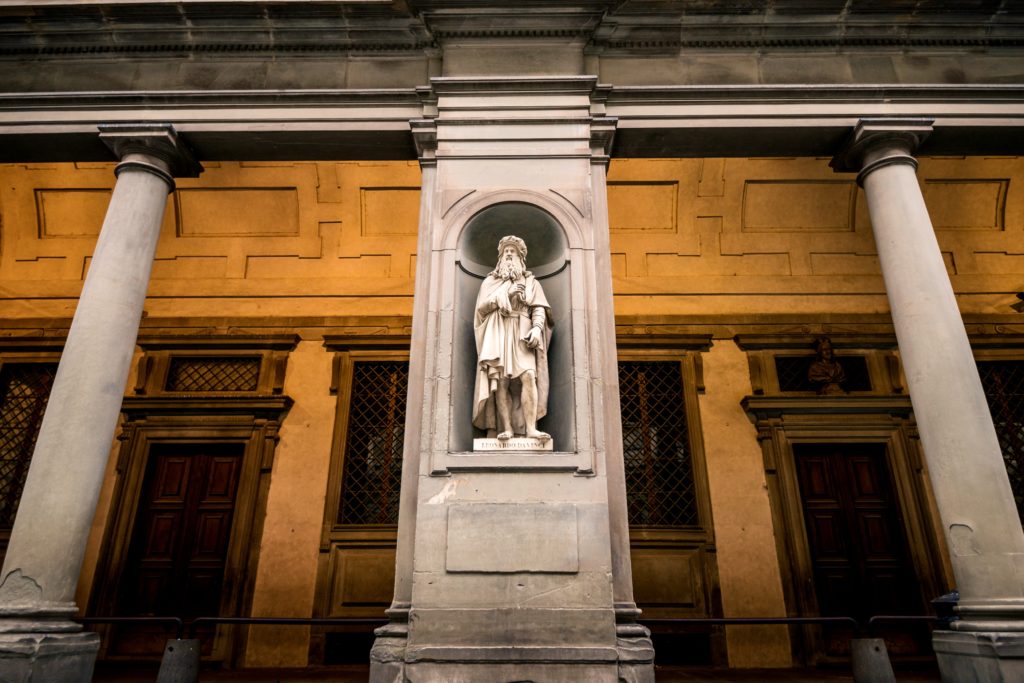
You’ll also see his drawings and anatomical studies. There are even recreations of his flying machines and, yes, even a robot he designed.
As a nod to the artist Leonardo, there’s also a life size reproduction of his Last Supper in Milan.
Click here to pre-book a ticket. Click here to book a 2 hour guided tour of the museum and a walking tour of Florence.
17. Stibbert Museum
Perfect for history and military buffs, the Stibbert Museum is one of Florence’s more unusual museums.
It houses the private collection of eccentric art collector Frederick Stibbert. When Stibbert inherited a fortune, he retired. Collecting art became his passion. Hard life, huh?
When Stibbert died, he gifted his villa to Florence. His museum is filled with an eclectic collection of artifacts, especially armory and weaponry, spread over 57 rooms.
One of the most important pieces is the “pwit costume,” made for the coronation of Napoleon as king of Italy in 1805.
Be sure to wander through the Medieval Room and the Hall of Knights. The latter has full scale replicas of horses and armory. That room’s only beat by the sheer number of samurai swords.
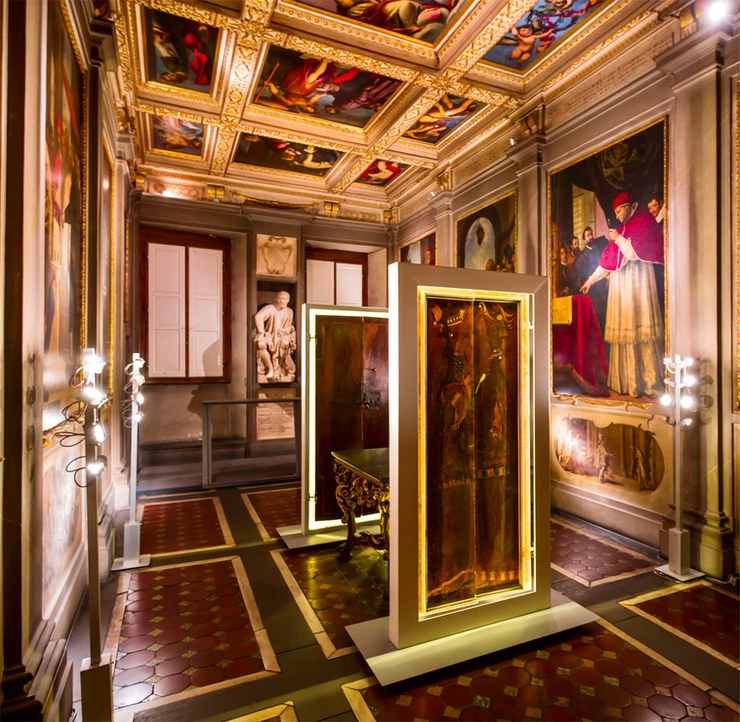
18. Casa Buonarotti
Casa Buonarroti is one of the best and most underrated museums in Florence.
The museum was a property once owned by the famed Renaissance artist Michelangelo, whose last name was Buonarroti. Later, the palace was transformed into a house-museum by his heirs.
The museum was designed to celebrate the great artist’s legacy. It’s a visual, and somewhat romanticized, biography of his life. If you’re a Michelangelo fan, Casa Buonarroti is a must visit attraction in Florence.
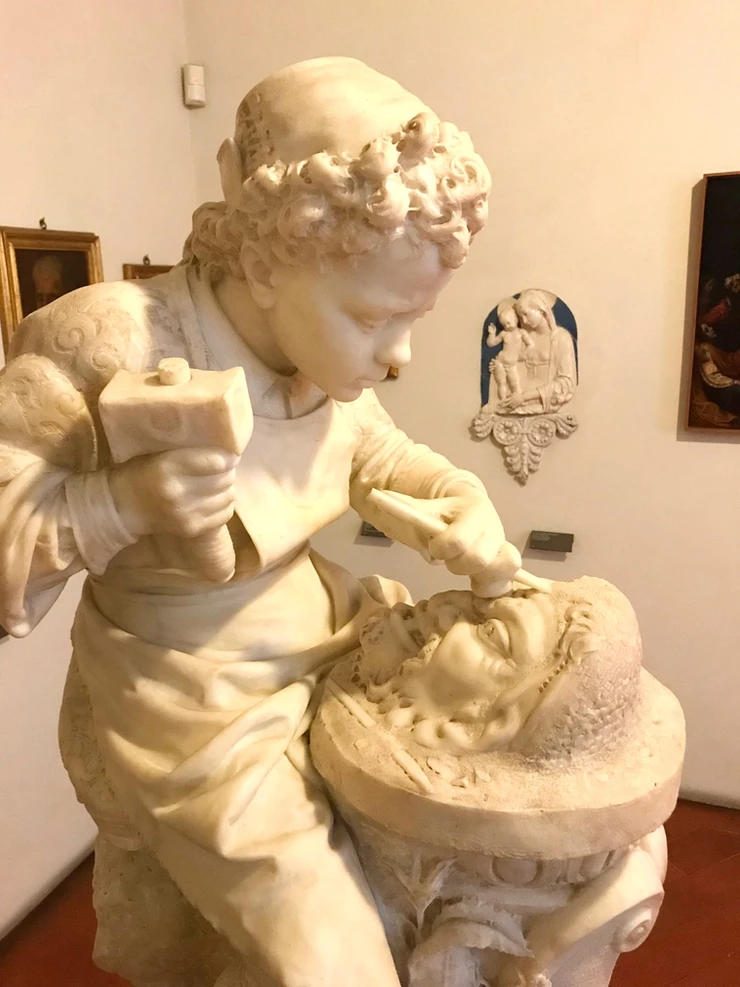
Casa Buonarroti has some real masterpieces. It has two of Michelangelo’s earliest known works of sculpture.
It houses Michelangelo’s majestic wooden model for the facade of the Basilica of San Lorenzo.
To top that, this tiny museum has the world’s second most important collection of Michelangelo drawings and a beautiful painting by Artemisia Gentileschi (that’s being restored).
19. Medici-Riccardi Palace
The fortress-like Medici-Riccardi Palace was home to the Medici family in the second half of the 15th century and a couple of decades of the 16th century.
The palace architect was Michelozzo, whom Cosimo the Elder commissioned in 1444. The Medici-Riccardi Palace is considered the first Renaissance style family palace — at least based on the interior.
Donatello’s avant garde Bronze David and Judith and Holofernes statues once stood in the courtyard, before moving to Palazzo Vecchio.
Today, you see a statue of Orpheus by late Renaissance Mannerist sculptor Baccio Bandinelli.
The Hall of Mirrors is an over the top Baroque confection with gold walls, dating from the 17th century. The illusionistic ceiling frescos were painted by Luca Giordano, with scenes from mythology
But the highlight of a visit to the palace is the Chapel of the Magi, a private chapel in the Medici home used exclusively for prayer and devotion.
The chapel is decorated with a beautiful series of frescos painted in 1459 by Benozzo Gozzoli. The frescos are in two parts, the Procession of the Magi is on three walls in the main room. The Adoration of the Magi in the chancel/altar.
The frescos are meant to glorify the Medici family and you’ll even see images of a young Lorenzo the Magnificent on horseback.
You can read more about this wonderful museum in Florence in my guide to the Medici palaces.
I hope you’ve enjoyed my guide to the best museums in Florence. You may find these other Florence travel guides useful:
- 1 day itinerary for Florence
- 2 day itinerary for Florence
- 3 Day Itinerary for Florence
- 1 Day Itinerary for Florence’s Oltrarno neighborhood
- Hidden gems in Florence
- Florence art bucket list
- How To See Michelangelo’s David
- The Basilica of San Lorenzo and the Medici Chapel
- Must See Sites in Florence
- Statues of the Piazza della Signoria
- Florence’s Duomo and Brunelleschi’s Dome
Pin it for later.

